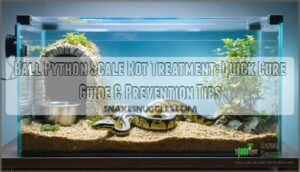This site is supported by our readers. We may earn a commission, at no cost to you, if you purchase through links.
 Ball python scale rot treatment starts with immediate quarantine in a clean, dry enclosure.
Ball python scale rot treatment starts with immediate quarantine in a clean, dry enclosure.
You’ll need to soak your snake in diluted betadine solution for 10-15 minutes daily, then apply antibiotic ointment like Neosporin to affected scales. Think of it as treating a nasty scrape – cleanliness is your best friend here.
Mild cases respond well to this home care within 1-2 weeks. However, severe infections with deep tissue damage require veterinary intervention and prescription antibiotics.
Don’t let humidity sit above 60% during recovery, or you’re fighting an uphill battle. Proper substrate changes and temperature control make all the difference in successful healing outcomes.
Table Of Contents
- Key Takeaways
- What is Ball Python Scale Rot
- Recognizing Ball Python Scale Rot Symptoms
- Causes of Scale Rot in Ball Pythons
- Diagnosing Scale Rot in Ball Pythons
- Ball Python Scale Rot Treatment Options
- Home Remedies for Ball Python Scale Rot
- Veterinary Care for Ball Python Scale Rot
- Preventing Scale Rot in Ball Pythons
- Frequently Asked Questions (FAQs)
- How do you treat scale rot in pythons?
- Will scale rot go away?
- What antibiotic is good for snake scale rot?
- Is scale rot an emergency?
- What is ball python scale rot?
- What causes a ball python to rot?
- Are ball pythons easy to care for?
- How do you treat scale rot?
- How long does scale rot treatment take?
- Can scale rot heal on its own?
- Conclusion
Key Takeaways
- You’ll need to act fast when you spot scale rot—quarantine your snake immediately in a clean, dry enclosure with paper towel substrate to prevent the bacterial infection from spreading.
- Daily betadine soaks for 10-15 minutes followed by antibiotic ointment application (like Neosporin without pain relievers) will treat mild cases within 3-6 weeks if you’re consistent.
- You can’t let humidity exceed 60% during recovery, and you’ll need to maintain temperatures between 75-85°F while keeping the enclosure spotlessly clean to create healing conditions.
- Don’t try to treat severe cases with deep tissue damage at home—you’ll need veterinary intervention with prescription antibiotics to prevent life-threatening complications like septicemia.
What is Ball Python Scale Rot
Scale rot is a bacterial infection that affects your ball python’s scales when poor enclosure conditions create the perfect breeding ground for harmful bacteria.
Dirty enclosures breed dangerous bacteria that turn your python’s protective scales into infected wounds requiring immediate intervention.
You’ll typically notice this condition on your snake’s belly scales first, where constant contact with contaminated substrate allows bacteria to penetrate damaged or weakened skin, leading to scale rot.
Definition of Scale Rot
Scale rot is a bacterial infection that creates skin lesions and scale damage on your ball python’s belly and lower body.
This reptile scale rot develops when harmful bacteria invade compromised scales, causing visible rot symptoms that worsen without proper infection control.
Key scale rot definition points include:
- Bacterial invasion through damaged scales
- Visible discoloration and blistering
- Progressive tissue breakdown
- Requires immediate treatment intervention
Common Causes of Scale Rot
Poor enclosure cleaning habits create the perfect storm for ball python scale rot.
When humidity levels exceed 60%, substrate choice becomes critical—wet bedding breeds bacteria.
Inadequate temperature control weakens your snake’s immune system, while snake trauma from rough handling or sharp objects opens infection pathways.
These scale rot causes work together, making prevention through proper husbandry your best defense against reptile scale rot.
Importance of Early Detection
Catching ball python scale rot in its tracks transforms a potential nightmare into a manageable situation.
Early detection through regular health checks and snake monitoring prevents minor discoloration from escalating into severe infections requiring extensive scale rot treatment.
Your scale inspection routine should focus on detection methods like checking for early warning signs including blisters, raised scales, or unusual coloration on your python’s belly.
Swift scale rot diagnosis means faster healing, reduced veterinary costs, and less stress for your snake.
Regular monitoring truly makes the difference between quick recovery and prolonged suffering.
Recognizing scale rot symptoms is essential for effective treatment and prevention of further complications.
Recognizing Ball Python Scale Rot Symptoms
You’ll need to examine your ball python’s belly and scales regularly to catch scale rot before it becomes serious.
Early detection involves looking for discolored scales, raised areas, or small blisters that indicate bacterial infection has started.
Discoloration on The Scales
Ball python scale discoloration serves as your first warning bell for scale rot symptoms.
Scale color changes manifest as red, brown, yellow, or greenish-black patches on belly scales, indicating bacterial infection’s early stages.
Watch for these color changes:
- Red inflammation spreading across ventral scales
- Brown patches appearing without recent shedding
- Yellow-tinged areas suggesting infection buildup
- Greenish-black spots indicating advanced scale damage
Blisters or Crusted Scales
When you spot blisters or crusted scales on your ball python, you’re looking at telltale signs of scale rot.
These fluid-filled bumps typically appear on belly scales that contact substrate most.
Scale infections create yellowish blisters that can rupture, forming crusted scales and skin lesions.
Early blister care prevents serious scale damage requiring intensive reptile scale rot treatment.
Raised Scales
Another telltale sign you’ll notice is raised scales that feel bumpy when you gently run your finger along your snake’s belly.
This happens when blood pools underneath, creating small lumps that signal potential scale infection requiring immediate wound care.
- Check for raised bumps by gently touching your python’s ventral scales
- Look for blood pooling beneath scales causing elevation and swelling
- Monitor areas where skin lesions or bacterial growth might develop
- Focus on belly scales that contact substrate most frequently
- Address scale damage quickly before it spreads to surrounding tissue
Lethargy and Loss of Appetite
Beyond visible scale damage, your ball python’s energy levels tell another story.
When lethargy signs appear alongside appetite loss, your snake’s battling more than skin-deep problems.
These snake behavior changes signal serious health decline requiring immediate attention.
- Sluggish movement – your normally active python barely moves around its enclosure
- Refused meals – feeding issues persist even with favorite prey items
- Extended hiding – spending excessive time in hide boxes avoiding interaction
These ball python health issues often accompany scale rot symptoms, making reptile scale rot management and ball python scale rot treatment urgent priorities for recovery.
Difficulty Shedding
When your ball python struggles with shedding issues, it’s often linked to scale damage from infection.
You’ll notice pieces of old skin clinging stubbornly, especially around problem areas.
Poor humidity control creates the perfect storm for both incomplete sheds and bacterial growth.
This double trouble weakens your snake’s natural defenses, making skin lesions more likely to develop and worsen.
Causes of Scale Rot in Ball Pythons
Understanding what causes scale rot in your ball python helps you prevent this bacterial infection before it starts.
You’ll find that excess humidity above 60%, poor enclosure hygiene, and physical injuries create the perfect conditions for harmful bacteria to thrive on your snake’s scales, which is a key factor in the development of scale rot.
Excess Humidity in The Enclosure
High humidity creates the perfect storm for bacterial growth in your ball python’s home.
When moisture levels exceed 60%, your snake’s scales become vulnerable to infection and damage.
Here’s what puts your python at risk:
- Inadequate ventilation – Poor airflow traps moisture like a greenhouse
- Wet substrate – Soggy bedding breeds harmful bacteria
- Excessive misting – Too much water creates dangerous conditions
Proper humidity control prevents costly vet bills.
Poor Enclosure Hygiene
While humidity creates the perfect storm, dirty substrate and poor enclosure maintenance provide the bacteria playground your snake doesn’t need.
Think of it like this—you wouldn’t sleep in unchanged bedding for weeks. Bacterial growth thrives in waste-soaked environments.
Establish cleaning schedules, remove waste promptly, and maintain proper reptile hygiene for effective scale rot treatment and prevention.
Burns, Cuts, or Other Wounds
Physical trauma creates perfect entry points for bacteria causing ball python scale rot.
Physical trauma includes snake bites from live prey, thermal burns from faulty heating, and skin lesions from sharp cage furniture, which damage your snake’s natural defense barrier.
Proper wound care and immediate laceration treatment prevent secondary infections.
It is crucial to check your enclosure for hazards regularly—that jagged hide or overheated ceramic heater could spell trouble for snake skin problems down the road.
Nutritional Deficiencies
Poor nutrition weakens your ball python’s immune system, making scale rot more likely.
Malnutrition effects include compromised healing and increased infection risk.
- Vitamin Deficit – Especially Vitamin A deficiency reduces immune function
- Mineral Imbalance – Calcium and phosphorus shortages affect scale health
- Protein Lack – Insufficient protein impairs tissue repair
- Dietary Insufficiency – Irregular feeding schedules create nutritional gaps
Recognizing signs of illness is essential for preventing scale rot and other health issues in ball pythons.
Stress
Beyond nutritional gaps, stress acts like a silent saboteur in your ball python’s health.
**Stress silently undermines your ball python’s immune system, creating perfect conditions for scale rot to take hold.
Snake anxiety from improper handling techniques or environmental stress weakens their immune defenses, opening doors for ball python scale rot.
Thermal stress from temperature swings and poor humidity management create perfect storm conditions.
Your snake’s constant hiding, defensive posturing, or refusal to eat signals distress.
Combat stress by maintaining consistent temperatures, providing secure hiding spots, and minimizing unnecessary handling.
Remember, a stressed snake equals a vulnerable snake.
Proper scale rot prevention is vital to guarantee the overall health and well-being of your ball python.
Diagnosing Scale Rot in Ball Pythons
Early detection of scale rot requires systematic examination of your ball python’s ventral scales, looking for discoloration, raised areas, or fluid-filled blisters.
You’ll need to differentiate between normal shedding patterns and bacterial infection symptoms through careful visual inspection and gentle palpation of affected scales, which is crucial for identifying bacterial infection.
Identifying Early Warning Signs
Watch for scale discoloration – brown, red, or greenish-black patches signal trouble ahead.
Blister formation creates fluid-filled bumps, while raised scales feel different under your fingertips.
These skin lesions mark early detection opportunities that’ll save your snake‘s health.
Ball python scale rot starts subtly, so regular belly checks catch scale rot symptoms before they worsen.
Conducting a Physical Examination
Once you’ve spotted the early warning signs, it’s time for a thorough Visual Examination of your ball python.
Handle your snake gently during this Scale Inspection – stressed pythons won’t cooperate.
Start with Skin Checks along the belly where ball python scale rot typically appears first. Look for discolored patches, raised scales, or fluid-filled blisters.
During your Wound Assessment, check for any cuts or abrasions that bacteria could exploit. Proper Snake Handling means supporting the body while examining each scale systematically.
Document any snake scale rot symptoms you discover – this information helps determine if you need professional reptile scale rot care.
Laboratory Testing
Veterinarians use specific diagnostic techniques to confirm ball python scale rot beyond visual inspection.
Laboratory testing provides definitive answers when symptoms aren’t clear-cut.
Essential microbial tests include:
- Bacterial cultures from scale samples to identify specific pathogens causing infection
- Tissue analysis through microscopic examination of affected scales and surrounding areas
- Sensitivity testing to determine which antibiotics will effectively treat the identified bacteria
Ball Python Scale Rot Treatment Options
Once you’ve identified scale rot in your ball python, you’ll need to act quickly with proven treatment methods that target the bacterial infection directly.
Effective treatment combines immediate quarantine, topical antiseptic applications, and supportive care to restore your snake’s health within 3-6 weeks for mild cases.
Quarantine in a Clean Enclosure
Your snake’s recovery journey starts with quarantine procedures—think of it as creating a sterile recovery room.
Remove your ball python from the contaminated environment immediately. Use paper towels instead of substrate for easy enclosure sanitizing. Clean all surfaces with reptile-safe disinfectant.
This snake isolation prevents reinfection and lets you monitor healing progress effectively during scale rot treatment.
Effective reptile disinfectant products are essential for reptile care solutions to prevent the spread of disease.
Soaking The Snake in Betadine Solution
Once you’ve quarantined your ball python, Betadine baths become your go-to scale rot treatment. This topical treatment works wonders for scale cleaning and promoting scale rot recovery.
Here’s your snake soaking protocol:
- Dilute Betadine to weak tea color (1:10 ratio with lukewarm water)
- Soak snake for 10-15 minutes while supervising closely
- Repeat daily until you see improvement in affected scales
When treating scale rot, to provide the best care for your ball python, you must understand snake health concerns
Applying Antibiotic Ointment
After thoroughly drying your snake, it’s time for antibiotic ointment application—the cornerstone of effective infection control.
Choose triple antibiotic ointment like Neosporin, avoiding pain-relief formulas that can irritate sensitive scales.
Apply this wound treatment directly to affected areas three times daily, ensuring complete scale cleaning beforehand.
Consistent ointment usage accelerates healing in your ball python scale rot treatment regimen.
Remember, topical antibiotics work best when combined with proper environmental conditions for thorough snake scale rot care.
Providing Supportive Care
Your ball python’s recovery depends on consistent supportive care beyond just treating the infection. Think of it as nursing your pet back to health.
- Hydration Methods: Provide fresh water daily and monitor drinking habits
- Humidity Control: Maintain 50-60% humidity levels using reliable hygrometers
- Snake Nutrition: Offer appropriately-sized prey to boost immune system recovery
- Wound Cleaning: Perform daily antiseptic treatments on affected scales
- Environmental Enrichment: Create stress-free conditions with proper hiding spots
Home Remedies for Ball Python Scale Rot
You can treat mild scale rot at home using proven antiseptic solutions and proper enclosure management. These evidence-based methods work effectively for early-stage infections when combined with improved husbandry practices.
Using Chlorohexidine Solution to Clean The Scales
Chlorohexidine offers powerful Scale Cleaning benefits for ball python scale rot treatment. This veterinary-grade solution provides effective Snake Hygiene when properly diluted.
Mix chlorohexidine at the correct ratio to create safe Cleaning Solutions for Scale Sanitizing.
Weekly
Apply gently with cotton swabs, focusing on affected areas. This scale rot cleaning method supports reptile scale rot prevention without harsh chemicals.
Regular scale rot treatment methods, such as proper scale care, are essential for maintaining healthy reptiles.
Applying Over-the-Counter Antibiotic Ointment
Triple-antibiotic ointment serves as your frontline defense against ball python scale rot progression.
After betadine cleaning, apply a thin layer of Neosporin (without pain relievers) directly to affected scales twice daily.
This topical care creates a protective barrier while delivering targeted wound treatment.
Over-the-counter medications like these provide effective antibiotic application for minor infections.
The use of antibiotic ointments relies on proper antibiotic properties to prevent infection.
Maintaining Proper Enclosure Conditions
After treating affected scales with antibiotic ointment, you’ll need proper temperature control at 75-85°F and humidity levels between 50-60%.
Your substrate choice matters—use paper towels for easy enclosure cleaning.
Install adequate ventilation systems to prevent moisture buildup.
Humidity control for ball pythons and temperature regulation for ball pythons through consistent reptile enclosure maintenance creates an environment where scale rot can’t thrive.
Veterinary Care for Ball Python Scale Rot
When home treatments don’t resolve your ball python’s scale rot within 3-5 days, you’ll need veterinary care to prevent serious complications.
A reptile veterinarian can prescribe stronger antibiotics, perform diagnostic tests, and recommend surgical intervention for severe cases that threaten your snake’s health.
When to Seek Veterinary Attention
While home treatments work for mild cases, some situations demand professional Emergency Care. Recognizing when Medical Intervention becomes necessary can save your snake’s life and prevent complications.
Vet Visits are essential when you observe these Severe Symptoms:
- Deep ulcers or open wounds that won’t heal after one week of treatment
- Systemic illness signs like refusing food for multiple weeks or extreme lethargy
- Spreading infection beyond the original Scale Infections site
Prescription Medications and Treatments
When home remedies aren’t cutting it, your vet becomes your python’s best friend.
Antibiotic therapy targets stubborn infections with prescription-strength medications like azithromycin or ceftazidime.
Topical creams pack more punch than over-the-counter options, promoting scale repair through targeted treatment.
Medication dosage varies by severity, while treatment duration typically spans several weeks for complete healing.
Surgical Options for Advanced Cases
Advanced scale rot treatment requires surgical intervention when conservative methods fail.
Your veterinarian performs debridement techniques to remove necrotic tissue, followed by wound closure and tissue repair.
Severe cases may need scale removal or even amputation procedures.
Snake scale rot surgery carries risks but offers hope when ball python scale rot threatens your pet’s life through systemic infection.
Preventing Scale Rot in Ball Pythons
You can prevent scale rot in your ball python by maintaining proper enclosure conditions and establishing consistent care routines.
Regular monitoring of humidity levels, substrate cleanliness, and your snake’s overall health will substantially reduce bacterial infection risks, which is crucial for preventing scale rot and ensuring the snake’s health.
Providing a Balanced Diet
Proper nutrition acts like armor against ball python scale rot treatment needs.
Meeting nutrient requirements through food variety strengthens your snake’s immune defenses. Vitamin needs and mineral intake support healthy skin that resists reptile skin problems.
A well-planned diet food guide is essential for preventing scale rot in ball pythons.
- Feed appropriate prey sizes – 10-15% of your python’s body weight
- Maintain feeding schedules – every 1-2 weeks for adults
- Choose quality prey – frozen-thawed rodents prevent injury and infection
Handling The Snake Gently and Hygienically
Beyond proper nutrition, gentle handling and hygiene practices form your defense against scale rot.
Wash your hands thoroughly before each interaction—oils and bacteria transfer easily to sensitive snake skin.
Move slowly when approaching your ball python, avoiding sudden movements that spike stress levels. Use a paper towel roll to gently announce your presence before lifting.
Support their body weight properly, allowing natural coiling around your arms. Clean handling techniques prevent reptile skin problems and reduce scale rot prevention risks substantially.
Monitoring The Snake’s Health Regularly
Weekly health checks become your snake’s best defense against scale rot and other serious conditions.
Regular scale inspection during handling sessions helps you catch problems before they escalate into costly veterinary emergencies.
- Monitor snake behavior for appetite changes, lethargy, or unusual hiding patterns
- Check humidity control weekly to maintain ideal 50-60% levels
- Examine scales closely for discoloration, blisters, or raised areas during routine handling
Frequently Asked Questions (FAQs)
How do you treat scale rot in pythons?
Scale rot spreads like wildfire if ignored.
You’ll quarantine your python immediately, apply diluted betadine baths twice daily, use antibiotic ointment without pain relievers.
Replace substrate with paper towels until healing’s complete, and follow these steps diligently to ensure your python recovers from the scale rot.
Will scale rot go away?
Scale rot won’t disappear on its own – you’ll need to treat it actively.
Mild cases heal within 3-6 weeks with proper care.
While severe infections require veterinary attention and can take months to resolve completely.
What antibiotic is good for snake scale rot?
Triple antibiotic ointment without pain relievers works well for mild cases. You’ll want Neosporin or Polysporin applied twice daily. Severe infections need prescription antibiotics from an exotic vet immediately.
Is scale rot an emergency?
While you might think scale rot’s just cosmetic, it’s actually a serious condition requiring prompt attention.
Early-stage scale rot isn’t immediately life-threatening, but advanced cases can cause septicemia and death without veterinary intervention.
What is ball python scale rot?
Ball python scale rot is a bacterial infection that affects your snake’s scales, causing discoloration, blisters, and inflammation.
It’s triggered by poor hygiene, excessive humidity, or injuries that let bacteria invade the skin.
What causes a ball python to rot?
Roughly 70% of captive snakes develop bacterial infections from poor husbandry.
You’re creating a breeding ground for pathogens when humidity exceeds 65%, temperatures drop below 75°F, or you let waste accumulate in dirty enclosures, which can lead to serious health issues for the snakes.
Are ball pythons easy to care for?
Yes, you’ll find ball pythons are beginner-friendly reptiles.
They’re docile, eat infrequently, and don’t require complex setups.
However, maintaining proper humidity and temperature is essential for preventing health issues like scale rot.
How do you treat scale rot?
Like fighting fire with water, you’ll need to quarantine your snake immediately.
Clean affected scales twice daily with diluted betadine, apply antibiotic ointment, and replace substrate with paper towels until healing’s complete.
How long does scale rot treatment take?
Treatment duration depends on severity—mild cases heal within 3-6 weeks with consistent daily care.
You’ll see improvement in days, but continue treatment for at least four weeks. Severe infections can take several months.
Can scale rot heal on its own?
Think of scale rot like a festering wound—it won’t magically disappear without intervention.
Your snake’s bacterial infection requires active treatment with proper cleaning, antibiotics, and environmental changes.
Ignoring it leads to serious complications.
Conclusion
Success in ball python scale rot treatment hinges on your swift action and consistent care.
You’ve learned the warning signs, treatment protocols, and prevention strategies that separate thriving snakes from struggling ones.
Remember, mild cases respond to home treatment within weeks, but severe infections demand veterinary intervention.
Don’t gamble with your python’s health—maintain proper humidity levels, guarantee enclosure cleanliness, and monitor regularly.
With dedication and proper technique, you’ll conquer scale rot before it conquers your snake.



















